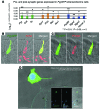Neuroepithelial circuit formed by innervation of sensory enteroendocrine cells
- PMID: 25555217
- PMCID: PMC4319442
- DOI: 10.1172/JCI78361
Neuroepithelial circuit formed by innervation of sensory enteroendocrine cells
Abstract
Satiety and other core physiological functions are modulated by sensory signals arising from the surface of the gut. Luminal nutrients and bacteria stimulate epithelial biosensors called enteroendocrine cells. Despite being electrically excitable, enteroendocrine cells are generally thought to communicate indirectly with nerves through hormone secretion and not through direct cell-nerve contact. However, we recently uncovered in intestinal enteroendocrine cells a cytoplasmic process that we named neuropod. Here, we determined that neuropods provide a direct connection between enteroendocrine cells and neurons innervating the small intestine and colon. Using cell-specific transgenic mice to study neural circuits, we found that enteroendocrine cells have the necessary elements for neurotransmission, including expression of genes that encode pre-, post-, and transsynaptic proteins. This neuroepithelial circuit was reconstituted in vitro by coculturing single enteroendocrine cells with sensory neurons. We used a monosynaptic rabies virus to define the circuit's functional connectivity in vivo and determined that delivery of this neurotropic virus into the colon lumen resulted in the infection of mucosal nerves through enteroendocrine cells. This neuroepithelial circuit can serve as both a sensory conduit for food and gut microbes to interact with the nervous system and a portal for viruses to enter the enteric and central nervous systems.
Figures



References
-
- Furness JB, Rivera LR, Cho HJ, Bravo DM, Callaghan B. The gut as a sensory organ. Nat Rev Gastroenterol Hepatol. 2013;10(12):729–740. - PubMed

